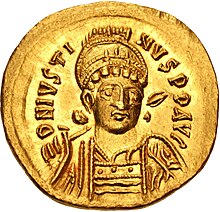
Back Justinus I van Bisantium Afrikaans Chustín I AN جستين الأول Arabic جستين الاول ARZ بیرینجی ژوستین AZB Юстин I Bulgarian Justin I BS Justí I el Vell Catalan Justinus I. Czech Justinus 1. Danish
| Justin I | |||||||||
|---|---|---|---|---|---|---|---|---|---|
 | |||||||||
| Byzantine emperor | |||||||||
| Reign | 9 July 518 – 1 August 527 | ||||||||
| Coronation | 10 July 518[a] | ||||||||
| Predecessor | Anastasius I | ||||||||
| Successor | Justinian I | ||||||||
| Co-emperor | Justinian I (from 1 April 527) | ||||||||
| Born | c. 450 Bederiana, Eastern Roman Empire | ||||||||
| Died | 1 August 527 (aged 77) Constantinople, Eastern Roman Empire | ||||||||
| Spouse | Euphemia | ||||||||
| Issue | Justinian I (adoptive) | ||||||||
| |||||||||
| Dynasty | Justinian | ||||||||
| Religion | Chalcedonian Christianity | ||||||||
| Justinian dynasty | ||
|---|---|---|
| Chronology | ||
|
||
| Succession | ||
|
||
Justin I (Latin: Iustinus; Ancient Greek: Ἰουστῖνος, romanized: Ioustînos; c. 450 – 1 August 527), also called Justin the Thracian (Latin: Iustinus Thrax; Ancient Greek: Ἰουστῖνος ὁ Θρᾷξ, romanized: Ioustînos ho Thrâix),[7] was Eastern Roman emperor from 518 to 527. Born to a peasant family, he rose through the ranks of the army to become commander of the imperial guard and when Emperor Anastasius I Dicorus died, he out-maneouvered his rivals and was elected as his successor, in spite of being around 68 years old. His reign is significant for the founding of the Justinian dynasty that included his eminent nephew, Justinian I, and three succeeding emperors. His consort was Empress Euphemia.
Justin was noted for his strongly orthodox Christian views. This facilitated the ending of the Acacian schism between the churches of Rome and Constantinople, resulting in good relations between Justin and the papacy. Throughout his reign, he stressed the religious nature of his office and passed edicts against various Christian groups seen at the time as non-Orthodox. In foreign affairs, he used religion as an instrument of state. He endeavoured to cultivate client states on the borders of the Empire, and avoided any significant warfare until late in his reign.
- ^ Martindale, Jones & Morris 1980.
- ^ Zacharias of Mytilene VIII, 1.
- ^ John Malalas XVII,1; Evagrius Scholasticus IV,1; Chronicon Paschale 518.
- ^ Constantine VII (c. 956), De Ceremoniis, I 93.
- ^ Walsh, Robert (1839). Constantinople and the Scenery of the Seven Churches of Asia Minor. British Library: Fisher, Son & Co. p. xxix.
- ^ Bury, John Bagnell (1958). History of the Later Roman Empire: From the Death of Theodosius I to the Death of Justinian, Volume 2. Mineola, New York: Dover Publications Incorporated. ISBN 0-486-20399-9.
- ^ Joannes Zonaras (c. 1140), Epitome, XIV 5.
Cite error: There are <ref group=lower-alpha> tags or {{efn}} templates on this page, but the references will not show without a {{reflist|group=lower-alpha}} template or {{notelist}} template (see the help page).